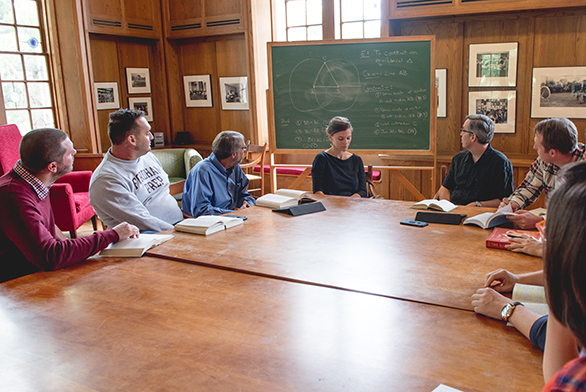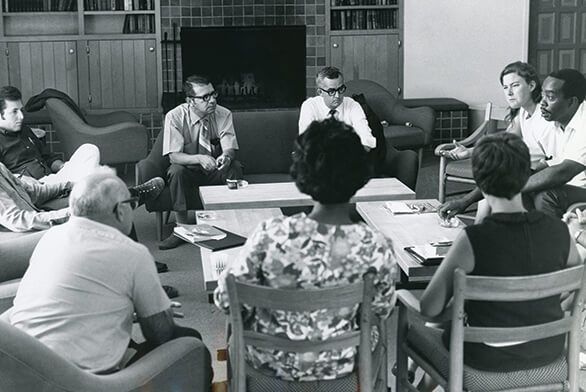Growing the Graduate Institute
Spring 2017 | By Robin Weiss (SFGI90) for The College

In the summer of 1967, on the three-year-old St. John’s Santa Fe campus, the Graduate Institute came to life as the Teachers Institute. The GI, as we know it during this 50th anniversary, offers a master of arts in liberal arts on both campuses year-round. In 1994, Santa Fe established a master of arts in Eastern classics, including two semesters of Sanskrit or classical Chinese.
“I characterized it this way,” says tutor emeritus Elliott Zuckerman, one of a handful of tutors in the GI pilot year: “Bringing inner city high school teachers” from Baltimore and New Mexico “to the high desert to read Aristotle.”
As GI director that second and third year, Zuckerman found that, for at least one student, 7,000 feet wasn’t high enough.
“I thought I had prepared for everything that first night. But the next morning, a number of students came to me and said their mattresses were missing.”
The mystery was solved when “one young man claimed to need to sleep higher than everyone else.”
Zuckerman describes how Richard Weigle, president and founder of the Santa Fe campus, and Robert Goldwin, first-year GI director (from Kenyon College), “invented the institute.” Politics and Society, designed by tutor Laurence Berns, was the only segment offered that first summer, with Freud’s Civilization and its Discontents heading the list for 35 students in two seminars.
“We lost money in the early years. We got scholarships for the students” from the Hoffberger and Cafritz Foundations, “covering tuition and compensating for their summer salaries. But we forgot to include the overhead. We always planned to have it in Annapolis but,” in the first years, as a summer institute only, “Annapolis wasn’t air conditioned.” Segments were added and the enrollment quickly doubled. By 1969, Literature and Poetry, Philosophy and Theology, and Mathematics and Natural Sciences joined Politics and Society.
“The curriculum was pretty much the same as now,” he says.
Zuckerman remembers when he and GI student William Yannuzzi (SFGI69)—a high school teacher who became musical director for the Baltimore Opera—criticized the previous night’s opera. “He and I would give an informal and scathing review to an audience at breakfast. It was a favorite event.”

“Weigle wanted to start something; he didn’t know it was the GI. From the first day, it was a success,” says Sam Kutler (Class of 1954), retired tutor and dean emeritus. “The Carnegie Foundation paid me six hundred dollars to formulate a math program. I would have paid that much to be able to do it. I think it’s been very successful. It was started for teachers; that was Bob Goldwin’s influence.” After the initial years as a summer-only institute in Santa Fe, “Without [tutor] Geoff Comber (H95), I don’t know what would have happened in Annapolis,” Kutler says.
“I had been in Santa Fe two or three summers,” says Comber, “and I was so impressed. I thought we were doing important work and we should do it here.” He remembers “quite strong objections,” with some Annapolis faculty saying: Why should we take on the risk? It took two years to get it off the ground, and in 1977 Comber operated as Annapolis GI director from his tutor’s office while he continued to teach full-time. “People were saying, ‘You can’t just do the same thing as Santa Fe,’ so I made up the history segment.” In 1988, the history segment was approved on both campuses as a fifth segment.
The vice president, Burch Ault, presented Comber with potential funding contacts around the country. “Everyone was impressed that we grew so fast,” Comber says. In 1980, while Comber was on sabbatical, Ben Milner took over the directorship and hired Sharon Hensley as full-time GI assistant. Over decades, “She was invaluable. A wonderful person to follow up on things,” says Comber. “It was going so well with the five segments, there was no reason to change anything.”
David Carl, who recently completed his term as Santa Fe associate dean for Graduate Programs (the title replacing director), knows well the administrative tasks “constantly going on behind the scenes, so that when tutors and students sit down at a table to talk about a book, it’s as if there’s nothing going on but that one activity.” Carl found it particularly appealing to work with “adults from amazingly diverse backgrounds. From firefighters to retired doctors, school teachers to surgeons, international business men and women to lawyers, bartenders, veterans, and physicists. They are giving up jobs, moving across the country, asking enormous sacrifices of their families.”
Part of the value of the Eastern Classics program, Carl explains, is how it exposes “the influence of Buddhism on Hume, or Hindu philosophy on Hegel, or Eastern thought in general on Nietzsche.” He describes how the EC program, developed with the help of past GI Director Krishnan Venkatesh, keeps the college in touch “with the deep-rooted notion of experimentation, which inspired the founders of the New Program.”
Carl stresses the necessity of education in a true democracy. “For adults out of college, I don’t know of a more vital part of that education in necessary citizenship than that provided by the opportunity to participate in true liberal education as offered by the St. John’s GI.”
Tom May, who served his first term as Annapolis GI director in 1986, reflects on the challenges of the early year-round program. May taught half-time, while he and assistant Hensley shouldered recruitment, alumni relations, budgeting, class assignments, and other student matters. They supervised high school visits, the Continuing Education and Fine Arts Program, and various publications. It was “truly prodigious labor, with no down time over the course of the year,” May recalls.
By May’s second directorship in 1995, the ancillary programs had “migrated to other offices. The GI was finally fully and solely itself. In the midst of these years of expansion, the program remained essentially the same.”
Recalling the GI in the 1970s, tutor David Starr refers to the Barr-Buchanan vision. “The concept of the college as a possible model for educating citizens of all backgrounds was alive and well in what we thought of as The Teachers Institute.” A past Santa Fe GI director, Starr reflects on “the resilience and range of the program” over the years. He writes of “a shift in demographics, from teachers funded to strengthen their competence, toward younger academics seeking to broaden their scope.” He explains that “people who specialized prematurely now come here to look into alternative philosophic, social, and spiritual studies.”
The current GI associate dean in Annapolis, Emily Langston, announced plans for a 50th celebration in her last year’s Commencement address. A number of events throughout this year will culminate at Homecoming on each campus. This anniversary year will highlight “the role of the GI as an integral part of the SJC community,” Langston says. “There’s a hunger for the sort of thing we offer at the GI. Someone who’s 80 and someone who’s 24 talk about a text together. I think the GI is the sort of thing that Barr and Buchanan were envisioning when they talked about how these books could speak to anyone.”

